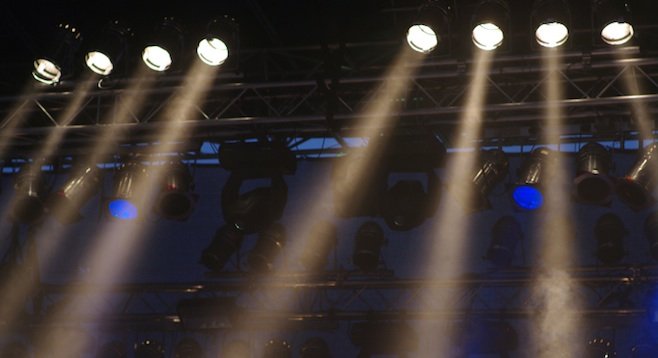 Facebook
Facebook
 X
X
 Instagram
Instagram
 TikTok
TikTok
 Youtube
Youtube


Most companies open every eight weeks or so. Their routines are often the same, at times almost identical: what people wear, where they cluster before the show and intermission, levels of excitement (the more intimate the theater, the louder the buzz), even how quickly people find their seats. And there will always be someone standing down front for all to see, heartily waving to friends in the house, whether they exist or not. The routines are usually just that. Some parts I always enjoy.
If you don’t count Cro-Magnons imitating life before flickering cavern walls, theater began outdoors. At ancient Rome and Greece, crowds filled great amphitheaters, as they did in Elizabethan times to see a play by Shakespeare or Ben Jonson. Be it at the Mount Helix Amphitheatre, the classic Greek stage at Point Loma Nazarene College, at the Moonlight on a summer’s eve, while teams play slow-pitch softball down the hill, or the beautifully rustic Lowell Davies Festival Stage in Balboa Park when macaws across the way bemoan the fading light: theater outdoors always feels special. Nature dwarfs the event.
I’m an inveterate people-watcher (and –listener). Each face, each piece of clothing, gesture, cast of the eyes has a story to tell. Going to the theater a lot gives me a pre-show show, a visual warm-up before I actor-watch inside. And how much can you gather from a glimpse? Which relationships are solid, which just for appearance sake? Who is “acting” before the curtain goes up? At intermission, if there is one, how much do the cares of the day remain on foreheads? Not only that, if the show is lame, I have a library in the house seats.
Take your pick. Every face is a novel. But for diversity, it’s the San Diego Rep, hands down: one of the most eclectic audiences around. For famous-people-watching: the La Jolla Playhouse. As at opening night for The Who’s Tommy, vaguely familiar-looking people would walk past — but a little shorter, a mite wider, or hair a different tint — and hey! Aren’t they Peter Townshend and Roger Daltrey of the Who? And over there: she almost looks… Wait. Wasn’t that Liza Minelli?
Lawrence Welk Resort Theatre is part of a village/hotel/golf course complex north of Escondido. Outside the theater, a bronze statue of Welk holding his baton greets visitors. Inside, people have their picture taken with a life-sized cutout of the maestro. One shoulder — the right one, I think — gets so worn down from an arm around it they have to replace the cutout periodically. “Oh, they like Lawrence Welk,” you scoff. But they’re immune to that sort of jabber. Mostly seniors, they adore Welk and Broadway musicals with a passion that youthens their years. They can be critical, make no mistake. But sit with them at South Pacific or The King and I and you can feel the memories stampede.
Sometimes on my way to a show, or just on my way, I’ll pass a place where theater used to thrive: the old Sixth Avenue Playhouse, where the Rep and later Sledgehammer Theatre blazed trails in a former funeral chapel; just down the street on Fifth, where Kim McCallum and the Bowery Theatre turned the small basement into a pressure cooker (I can still see McCallum, in When Ya Comin’ Back Red Ryder?, shoving his index finger into a foot-tall table fan to see if he could stop it from spinning); or the little storefront on Fourth, half a block south of Market, where Kit Goldman and the Gaslamp Quarter Theatre performed Noel Coward with elegance and introduced feminism to San Diego stages. The Gaslamp was on lower Broadway, mind you, the meanest streets in town at the time.
I started asking for back-row seats 20–25 years ago, for a couple of reasons: in those days there’d be no one talking behind me; I take many notes, which bothered people. So bother fewer. What made the choice permanent was the time I was sneezed on, can’t recall the theater. It was a real nasal barrage. Ergo: the back row. Other reasons: the rear seats have more leg room in some theaters. Except for the San Diego Civic, the back row isn’t all that far from the stage. And, if the actors want to play to all the critics on opening night, and not just the ones down front, they’ll have to project to the entire house.



Most companies open every eight weeks or so. Their routines are often the same, at times almost identical: what people wear, where they cluster before the show and intermission, levels of excitement (the more intimate the theater, the louder the buzz), even how quickly people find their seats. And there will always be someone standing down front for all to see, heartily waving to friends in the house, whether they exist or not. The routines are usually just that. Some parts I always enjoy.
If you don’t count Cro-Magnons imitating life before flickering cavern walls, theater began outdoors. At ancient Rome and Greece, crowds filled great amphitheaters, as they did in Elizabethan times to see a play by Shakespeare or Ben Jonson. Be it at the Mount Helix Amphitheatre, the classic Greek stage at Point Loma Nazarene College, at the Moonlight on a summer’s eve, while teams play slow-pitch softball down the hill, or the beautifully rustic Lowell Davies Festival Stage in Balboa Park when macaws across the way bemoan the fading light: theater outdoors always feels special. Nature dwarfs the event.
I’m an inveterate people-watcher (and –listener). Each face, each piece of clothing, gesture, cast of the eyes has a story to tell. Going to the theater a lot gives me a pre-show show, a visual warm-up before I actor-watch inside. And how much can you gather from a glimpse? Which relationships are solid, which just for appearance sake? Who is “acting” before the curtain goes up? At intermission, if there is one, how much do the cares of the day remain on foreheads? Not only that, if the show is lame, I have a library in the house seats.
Take your pick. Every face is a novel. But for diversity, it’s the San Diego Rep, hands down: one of the most eclectic audiences around. For famous-people-watching: the La Jolla Playhouse. As at opening night for The Who’s Tommy, vaguely familiar-looking people would walk past — but a little shorter, a mite wider, or hair a different tint — and hey! Aren’t they Peter Townshend and Roger Daltrey of the Who? And over there: she almost looks… Wait. Wasn’t that Liza Minelli?
Lawrence Welk Resort Theatre is part of a village/hotel/golf course complex north of Escondido. Outside the theater, a bronze statue of Welk holding his baton greets visitors. Inside, people have their picture taken with a life-sized cutout of the maestro. One shoulder — the right one, I think — gets so worn down from an arm around it they have to replace the cutout periodically. “Oh, they like Lawrence Welk,” you scoff. But they’re immune to that sort of jabber. Mostly seniors, they adore Welk and Broadway musicals with a passion that youthens their years. They can be critical, make no mistake. But sit with them at South Pacific or The King and I and you can feel the memories stampede.
Sometimes on my way to a show, or just on my way, I’ll pass a place where theater used to thrive: the old Sixth Avenue Playhouse, where the Rep and later Sledgehammer Theatre blazed trails in a former funeral chapel; just down the street on Fifth, where Kim McCallum and the Bowery Theatre turned the small basement into a pressure cooker (I can still see McCallum, in When Ya Comin’ Back Red Ryder?, shoving his index finger into a foot-tall table fan to see if he could stop it from spinning); or the little storefront on Fourth, half a block south of Market, where Kit Goldman and the Gaslamp Quarter Theatre performed Noel Coward with elegance and introduced feminism to San Diego stages. The Gaslamp was on lower Broadway, mind you, the meanest streets in town at the time.
I started asking for back-row seats 20–25 years ago, for a couple of reasons: in those days there’d be no one talking behind me; I take many notes, which bothered people. So bother fewer. What made the choice permanent was the time I was sneezed on, can’t recall the theater. It was a real nasal barrage. Ergo: the back row. Other reasons: the rear seats have more leg room in some theaters. Except for the San Diego Civic, the back row isn’t all that far from the stage. And, if the actors want to play to all the critics on opening night, and not just the ones down front, they’ll have to project to the entire house.
Comments